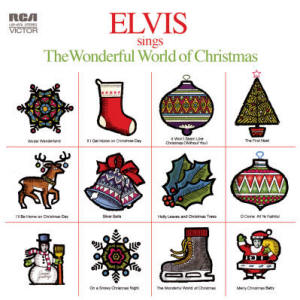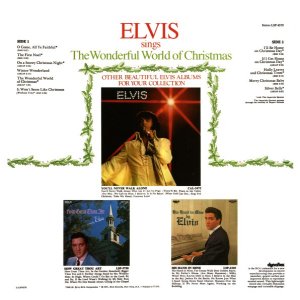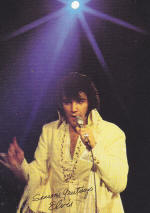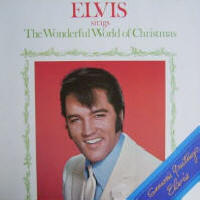Verdict
In early 1971 Elvis wasn't in great voice, but his affected timbre fits the mood of the songs perfectly. To me "Elvis Sings The Wonderful World Of Christmas" is a good, atmospheric Christmas album.
![]()
(C) RCA Records
The ultimate site about the king of the analogue age


Encouraged by the success of CAMDEN's "Elvis Christmas Album" RCA Victor released a new set of Christmas music in October 1971. On December 4th "Elvis Sings The Wonderful World Of Christmas" entered Billboard's special "Christmas Chart", stayed for four weeks and peaked at number 2. In the following two years the album would make it to the number one of this chart. In December 1977, a few months after the king's demise, "Elvis Sings The Wonderful World Of Christmas" also was listed on the "Hot Country LPs Chart", had a run of seven weeks and peaked at number 13. The RIAA honored the domestic sales with Gold (1977), Platinum (1977), Double Platinum (1988) and Tripple Platinum (1999). The golbal sales are estimated at 5 million units, which equals 750 million paid streams of the whole album or 7.5 billion paid streams of individual tracks. Commercially Elvis' second Christmas album was as successful as the first one and belogs to the best selling long players of his catalogue.
In 2016 the complete Presley catalogue was restored and remastered by Vic Anesini for a boxed set of 60 compact discs called "The Album Collection". Sony Music Entertainment provides the streaming platforms with the same versions of the individual albums (in this case with "If Every Day Was Like Christmas" as bonus track), albeit in 24 bit/90 khz flac. That means, if the platform of your choice supports high resolution audio, you can enjoy the tracks in the same quality Sony used to scan and master them. On Spotify, which has a market share of approximately 30% and is the only platform that publishes streaming figures, "Elvis Sings The Wonderful World Of Christmas" accumulates 50 million streams. So while the physical edition sold as well as the king's original seasonal longplayer, the digital version of "Elvis' Christmas Album" was streamed 20 times as much as its successor. Combined all of the king's Xmas albums (the two original releases plus compilations) mount up to 10 billion streams. So Mr. Presley may also be called King Of Christmas.
Instead of the by now usual concert photo RCA Victor used festive sybols on the front cover. However, they couldn't resist to abuse the backside of the sleeve to promote the recent budget compilation "You'll Never Walk Alone" and Elvis' gospel albums "His Hand In Mine" (1960) and "How Great Thou Art" (1967). Maybe Colonel Parker didn't want to do without the madatory live picture and ordered the record label to include a photo postcard on the first edition.

In Europe RCA opted for a different cover. Here the label used a photo of the king wearing a suit and a tie. The picture had been made in late 1968 to promote the MGM flick "The Trouble With Girls (And How To Get Into It)". Even though I like the original US cover, I prefer the European one. Maybe simply because this is "my" edition of "Elvis Sings The Wonderful World Of Christmas".

The songs were recorded on May 15 and 16, 1971 at RCA Studio B in Nashville/Tennessee. Elvis' band consisted of James Burton (guitar), Chip Young (guitar), Charlie Hodge (guitar), Norbert Putnam (bass), Jerry Carrigan (drums, May 15th), Kenneth Buttery (drums, May 16th), David Briggs (piano) and Glenn Spreen (organ). The harmony vocals were provided by The Imperials (Jimmie Murray, Terry Blackwood, Greg Gordon and Joe Moscheo) as well as Millie Kirkham, Temple Riser and Ginger Holladay.
Fourty years after the original release Follow That Dream Records issued a collector's edition, that also included several outtakes. You get to the review by tapping HERE.
O Come, All Ye Faithful
The hymn is based on "Adeste Fideles" and was composed in 1743 by John Francis Wade. In 1823 Friedrich Heinrich Ranke translated it to "Herbei, O Ihr Glaeubigen", twentynine years later Frederick Oakeley and Thomas Brooke turned it into "O Come, All Ye Faithful". Elvis recorded two takes of this classic on May 16, 1971 and chose the first attempt as master take. On June 21st horns and strings were added, on July 26th Felton Jarvis also added an organ. The arrangement is bombastic and somewhat kitschy, but the drums are played quite hard, like on a rock song. I like this version of "O Come, All Ye Faithful" very much.
The First NoelAfter the flying start the album gets more quiet. Accompanied by organ, brass, piano and cymbals Elvis and the choir perform a beautiful version of this classic. The word "noel" means "Christmas" and is based on the Latin word "natalis" (birthday). The origins of this traditional can be found in the 18th century, the versions known today are based on the arrangement by John Stainer, who released it in 1871 in a book called "Carols, Old And New". Elvis recorded his version on May 16, 1971. Because the old magnetic tapes are missing, it's unknown how many takes he needed to reach a satisfactory result. However, we do know that the master take was spiced up with additional harmony voices on May 24th.
On A Snowy Christmas NightAs the title suggests, the song describes a snowy Christmas night. In contrast to the first two tracks, this one was written by Stanley J. Gelber directly for this recording project. This one was also put on tape on May 16, 1971 and therefore we don't know any further details. On May 24th Felton Jarvis added more harmony voices, on June 22nd strings were overdubbed. Once again I like the result very much.
Winter WonderlandThe arrangement is on the rocking side, James Burton offers some nice guitar licks and the song features the famous "Elvis Ending". It all sounds good in theory, but unfortunately Elvis couldn't warm up to the song and didn't do anything to hide it. He sang the song ten times and picked the final attempt as master take. "Winter Wonderland" was written by Dick Smith and Felix Bernard and was recorded for the first time in 1934 by Guy Lombardo & His Royal Canadians. Since then it has been covered countless times and belongs to the best known songs of this kind.
The Wonderful World Of ChristmasThe title song of this album was written by Charles Tobias and Al Frisch and includes a truckload of festive stereotypes. Nevertheless it's a good song and performed very well. Once again the original tapes are missing, so it's unknown how many takes Elvis did. But we do know, that harmony voices were overdubbed on June 24th and horns and strings were added on July 21st.
It Won't Seem Like Christmas (Without You)In a seasonal setting the singer mourns for the past, because his loved one left him. In general I like this slightly bluesy song very well, but somehow I get the impression that Elvis didn't take "It Won't Seem Like Christmas (Without You)" seriously. He recorded the song by J. A. Balthrop on May 15, 1971 within seven takes, overdubbs were done on May 24th (harmony voices) and June 22nd (strings).
I'll Be Home On Christmas DayThe blue mood continues with "I'll Be Home On Christmas Day", written by Michael Jarret. On May 16, 1971 Elvis recorded eight takes of this great song, but wasn't pleased with the result. So he tried again on June 10th. In the end he went for his first version, but had drums and strings added on June 22nd. I think the bowed instruments should have been left out, because they are too saccarine.
If I Get Home On Christmas DayOnce again the singer wants to get home, but this time he's in a happy mood and looks forward to see everyone again. Elvis recorded the song by Tony Macaulay on May 15, 1971 and selected the 8th attempt for post-production and release. Felton Jarvis added harmony voices on May 24th and horns and strings on June 21st.
Holly Leaves And Christmas TreesRed West and Glen Spreen wrote this sentimental song for Elvis and he performs it very well. The singer wistfully looks back to previous Christmases and comes to realize that it's not the same since his loved one left him. The king needed ten takes to archive a satisfactory result. The master take was recorded on May 15th, harmony vocals followed on May 24th and strings were added on June 22nd. Once again I think the song would have benefited by leaving out the strings.
Merry Christmas BabyThis is an outstanding performance, on this album as well as in general. Without doubt "Merry Christmas Baby" is one of the best blues recordings Elvis has ever done. The song was put on tape on May 15, 1971 within a single take. The man is on fire and the band is playing at full throttle. It's almost a jam and it's a joy to hear how the guys were reacting to each other and how much fun they had. Felton Jarvis shortened the recording and had Eddie Hinton add a guitar solo on July 26, 1971. To promote the album, RCA Victor released "Merry Christmas Baby" on a single, which barely sold 100,000 units - worldwide! Why this great track turned out to be a commercial disaster cannot be explained. By the way: The song was written by Johnny Moore and Rou Baxter and recorded for the first time in 1947 by Johnny Moore's Three Blazers.
Silver BellsThe album ends with a movie tune from "The Lemon Drop Kid" (1951). On the silver screen it was performed by Bob Hope and Marilyn Maxwell, the recorded version was by Bing Crosby and Carol Richards. The song was written by Ray Evans and Jay Livingston and I still cannot help to regard this song to be pure irony. The composers describe the stressful and hectic pre-Christmas shopping in romantic words and wrap it in a saccarine melody. However, Elvis takes the song seriously and performs it in an emotional way. On May 15, 1971 the king recorded three takes of "Silver Bells" and selected the second one as master take. On May 24th harmony voices were added, strings followed on June 22nd and bells on July 26th.
In early 1971 Elvis wasn't in great voice, but his affected timbre fits the mood of the songs perfectly. To me "Elvis Sings The Wonderful World Of Christmas" is a good, atmospheric Christmas album.
![]()
(C) RCA Records